2020 Ford Escape
#46
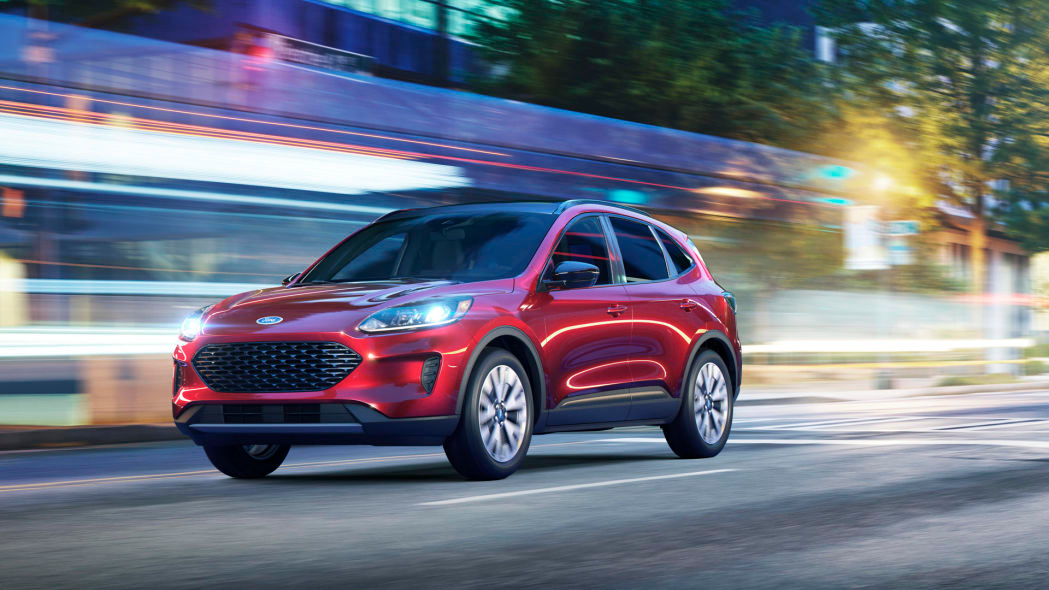
The all-new 2020 Ford Escape comes at an interesting time for Ford. By dropping its sedan and hatchback lines in the U.S., Ford is hoping (and frankly, betting) that its lineup of completely re-conceived crossovers and SUVs, like the significantly improved, all-new 2020 Ford Explorer, will absorb those car buyers and attract new ones. To that end, the reborn Escape is more car-like in appearance than before, riding on the same platform as the next-generation Focus we'll never get, and looking more like a jacked-up hatchback than anything that might tackle an off-road adventure. Itís handsome, but it is also the opposite of the direction Toyotatook with its sales-leading RAV4, which adopted a more rugged look and feel in its most recent redesign.
By making the Escape even less like a truck and even more like a car, Ford aims to offer its customers the best of both worlds ó the driving dynamics of a fun hatchback with the elevated seating position that American buyers want. And for the most part, itís successful in that mission.
Visualizing the 2020 Escapeís car-ification requires no more than a quick glance at its sheetmetal, particularly at the front. Ford says the trapezoidal shape of the Escape's grille opening is inspired by the Mustang and that its lower front fascia borrows design cues from the GT supercar ó tellingly, thereís no mention of Fordís sales-leading pickup trucks in the design discussion. The roof slopes dramatically toward the rear of the vehicle, which makes the latest Escape look like a highly aerodynamic lozenge when viewed in profile. It also means rearward visibility over the driverís shoulder is basically nonexistent.
By making the Escape even less like a truck and even more like a car, Ford aims to offer its customers the best of both worlds ó the driving dynamics of a fun hatchback with the elevated seating position that American buyers want. And for the most part, itís successful in that mission.
Visualizing the 2020 Escapeís car-ification requires no more than a quick glance at its sheetmetal, particularly at the front. Ford says the trapezoidal shape of the Escape's grille opening is inspired by the Mustang and that its lower front fascia borrows design cues from the GT supercar ó tellingly, thereís no mention of Fordís sales-leading pickup trucks in the design discussion. The roof slopes dramatically toward the rear of the vehicle, which makes the latest Escape look like a highly aerodynamic lozenge when viewed in profile. It also means rearward visibility over the driverís shoulder is basically nonexistent.
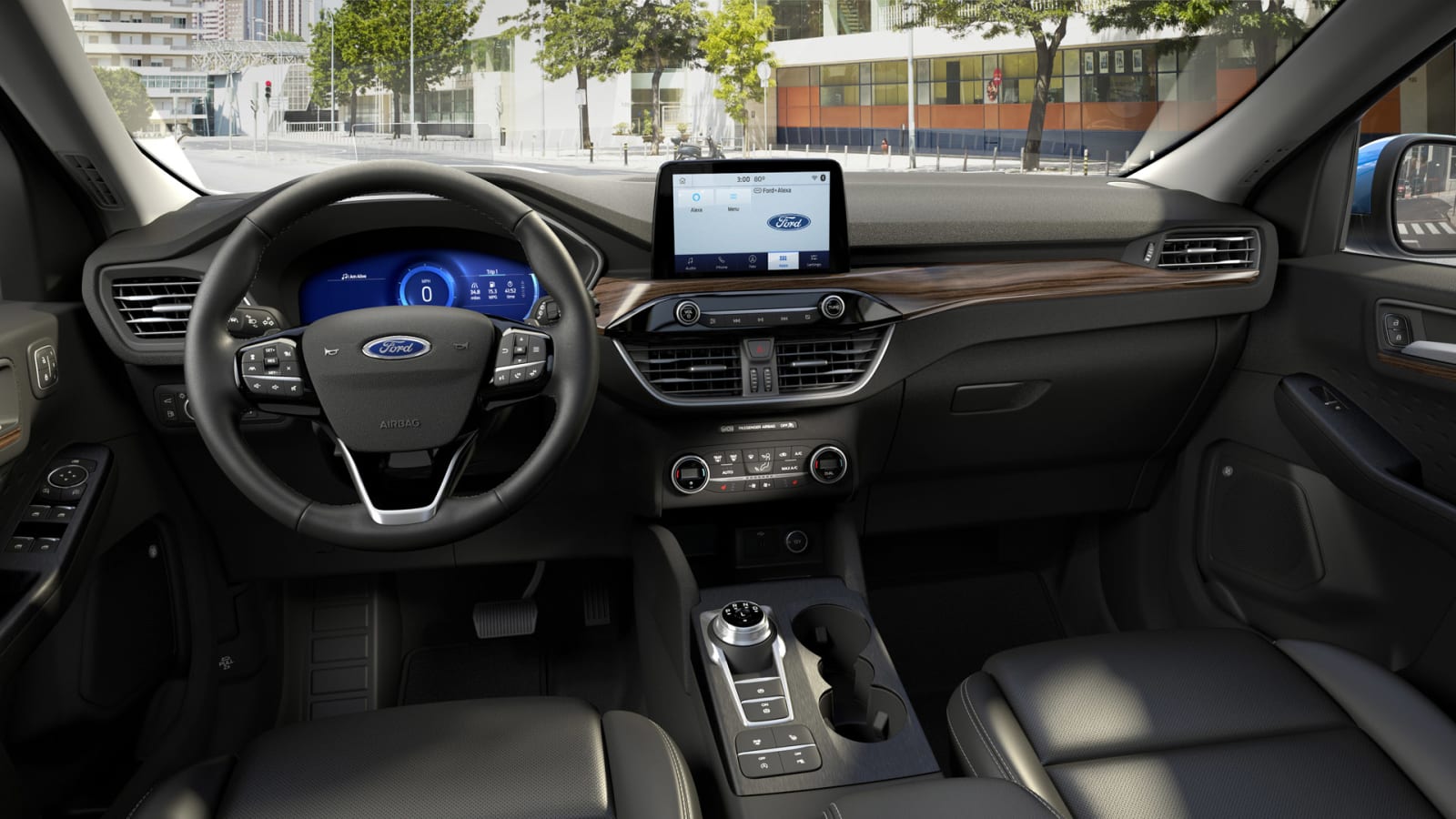
Inside, the 2020 Escape has some fancy and eye-catching optional technology to help set it apart from its competitors. We like the available 12.3-inch digital instrument cluster, in part because it offers more than just a replication of traditional gauges and dials. The cluster is configurable, and it offers a different visual representation for each available drive mode ó Normal, Sport, Eco, Slippery, and Snow and Sand. Thereís also a 6-inch head-up display that unfolds from the top of the dashboard to put relevant information directly in the driverís line of sight.
The 2020 Escape is roomy inside, particularly in the back seat. The second row now slides 6 inches fore and aft, and in its rearmost position, offers a class-leading 40.7 inches of legroom. In the real world, that means a 6-footer will have no problem getting comfortable in the back seat behind another 6-footer in the front. If you position those rear seats as far forward as theyíll go, thereby significantly reducing rear legroom, thereís as much as 33.5 cubic-feet behind them. That's less than the outgoing Escape's 34 cubic-feet, which was available with the seat in its fixed and therefore rearmost position. A Honda CR-V and Subaru Forester also have more with their fixed seats raised as well as lowered. The new Escape's maximum cargo space is 65.4 cubic-feet, which is average for the segment, but about 10 cubes shy of the Honda and Subaru. The outgoing Escape's maximum is 68 cubic-feet. At least the 2020 Escape's cargo area is well-shaped and accessible ó we saw Ford put four full sets of golf clubs and bags in the back of an Escape, and there was room for more.
While its space utilization is good, we have some complaints about the new Escapeís interior detailing. Most everything the driver will regularly come into contact with is of reasonable and competitive quality, but between those touch points are some iffy bits. Particularly annoying are the door panels molded out of a sort of squishy foam-like plastic, and rigid sun visors that impede too much of the view forward when in use.
The 2020 Escape is roomy inside, particularly in the back seat. The second row now slides 6 inches fore and aft, and in its rearmost position, offers a class-leading 40.7 inches of legroom. In the real world, that means a 6-footer will have no problem getting comfortable in the back seat behind another 6-footer in the front. If you position those rear seats as far forward as theyíll go, thereby significantly reducing rear legroom, thereís as much as 33.5 cubic-feet behind them. That's less than the outgoing Escape's 34 cubic-feet, which was available with the seat in its fixed and therefore rearmost position. A Honda CR-V and Subaru Forester also have more with their fixed seats raised as well as lowered. The new Escape's maximum cargo space is 65.4 cubic-feet, which is average for the segment, but about 10 cubes shy of the Honda and Subaru. The outgoing Escape's maximum is 68 cubic-feet. At least the 2020 Escape's cargo area is well-shaped and accessible ó we saw Ford put four full sets of golf clubs and bags in the back of an Escape, and there was room for more.
While its space utilization is good, we have some complaints about the new Escapeís interior detailing. Most everything the driver will regularly come into contact with is of reasonable and competitive quality, but between those touch points are some iffy bits. Particularly annoying are the door panels molded out of a sort of squishy foam-like plastic, and rigid sun visors that impede too much of the view forward when in use.
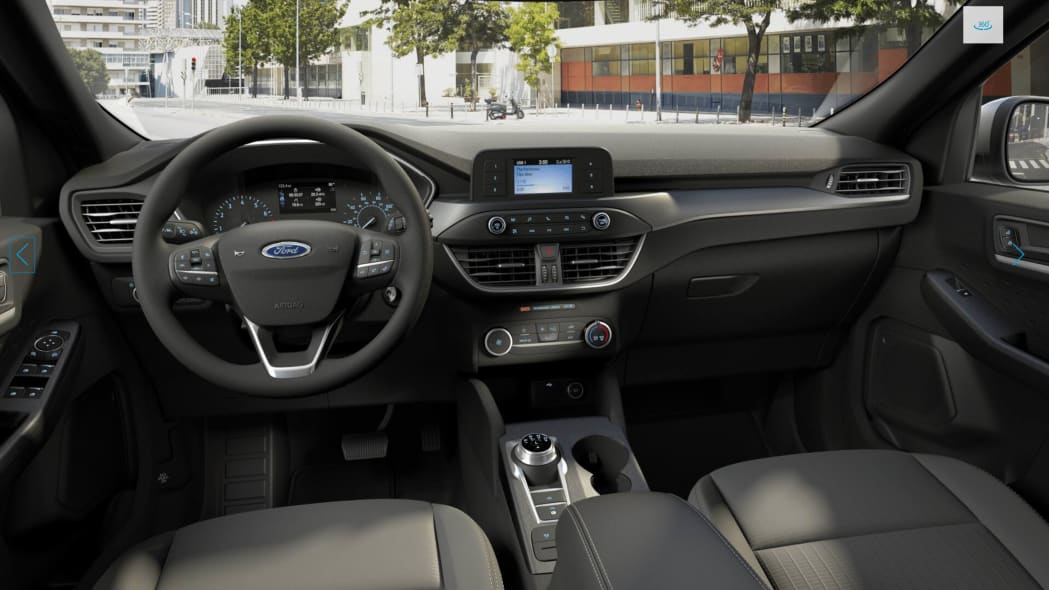
The 2020 Escapeís base 1.5-liter turbocharged engine is the segment's only three-cylinder. It spins out 181 horsepower and 190 pound-feet of torque, which puts it roughly on par or better than the CR-V and Subaru Forester. Whereas those competitors use continuously variable transmissions, Ford sticks with a conventional eight-speed automatic. Thatís good news for most driving situations, as the gearbox feels smooth and responsive in normal driving duties. Where this small-displacement engine falls flat, though, is power right off idle. Itís not until about 10 mph or so until the turbo really gets spinning and the power starts to build. Until that happens, the driver is keenly aware that there are only three relatively small pistons cranking away under the Escapeís hood. To put it bluntly, itís decidedly slow when moving off from a stop Ė but once it hits its groove, itís adequate.
Buyers who want a bit more oomph (and cylinders) can opt for a 2.0-liter turbocharged inline-four that offers 250 horsepower and a class-leading 280 lb-ft on premium fuel. Itíll run fine on regular gas but will make a little less power. The bigger engine is also hooked up to an eight-speed automatic, and while itís certainly quicker than its 1.5-liter sibling, even the larger engine option is sometimes caught flat-footed at low RPMs until the boost builds. Once under way, passing power from the 2.0-liter is very good due to its abundance of midrange torque, and itís rated to tow as much as 3,500 pounds.
An optional all-wheel drive system features rear wheels that disconnect from the rest of the drivetrain until the carís computer senses slip, which helps reduce fuel consumption. The EPA rates Escapes powered by the 1.5-liter at 27 city, 33 highway, and 30 combined with front-wheel drive or 26/31/28 with all-wheel drive. The all-wheel-drive 2.0-liter is rated at 23/31/26. For the sake of comparison, then most efficient last-gen Escape used a 1.5-liter four-cylinder engine and was rated at 23 city, 30 highway, and 26 combined, so the new powertrains are major improvements over the old.
Buyers who want a bit more oomph (and cylinders) can opt for a 2.0-liter turbocharged inline-four that offers 250 horsepower and a class-leading 280 lb-ft on premium fuel. Itíll run fine on regular gas but will make a little less power. The bigger engine is also hooked up to an eight-speed automatic, and while itís certainly quicker than its 1.5-liter sibling, even the larger engine option is sometimes caught flat-footed at low RPMs until the boost builds. Once under way, passing power from the 2.0-liter is very good due to its abundance of midrange torque, and itís rated to tow as much as 3,500 pounds.
An optional all-wheel drive system features rear wheels that disconnect from the rest of the drivetrain until the carís computer senses slip, which helps reduce fuel consumption. The EPA rates Escapes powered by the 1.5-liter at 27 city, 33 highway, and 30 combined with front-wheel drive or 26/31/28 with all-wheel drive. The all-wheel-drive 2.0-liter is rated at 23/31/26. For the sake of comparison, then most efficient last-gen Escape used a 1.5-liter four-cylinder engine and was rated at 23 city, 30 highway, and 26 combined, so the new powertrains are major improvements over the old.





The 2020 Escape is more than 200 pounds lighter than the 2019 model, despite being slightly larger in nearly every meaningful dimension. That reduction in mass pays dividends out on the road, where the Escape feels confident and surefooted. Itís not as fun to toss around as the enthusiast-favorite Mazda CX-5, but the chassis is stiff and the suspension is just on the firm side of comfortable (much as the outgoing Escape's was), making it one of the more engaging options in its segment. As is the case with most modern compact crossovers, the Escapeís steering is overboosted and light but not egregiously so.
Really, the 2020 Escape drives more like a Focus thatís been jacked up a few extra inches off the ground Ė because thatís exactly what it is. The outgoing Escape could be described similarly as it too was mechanically based on a Focus, but for 2020, the dial has been turned even further toward "car." Ford is hoping this change will capture a large percentage of buyers who would otherwise be lost by the death of the Focus and the impending death of the Fusion. However, that leads us to the Escapeís price.
The 2020 Escape starts at $26,080 in base S trim (including a $1,195 destination charge), which comes standard with Fordís Co-Pilot 360 safety tech package that includes lane-keep assist and automatic emergency braking. Thatís right on par for the segment, but much higher than the $21,415 asking price of the now-dead Focus or even the $24,165 for a base 2020 Fusion S. Obviously, the Escapeís pricing rises from there. An Escape SE with Fordís Sync 3 infotainment system, which includes an 8-inch screen along with Android Auto and Apple CarPlay, costs $28,290. All-wheel drive is optional on most models for a $1,500 surcharge. If you want the 2.0-liter EcoBoost, which comes standard with all-wheel drive, an SEL will run $33,835 and a range-topping Escape Titanium costs $37,480.
Really, the 2020 Escape drives more like a Focus thatís been jacked up a few extra inches off the ground Ė because thatís exactly what it is. The outgoing Escape could be described similarly as it too was mechanically based on a Focus, but for 2020, the dial has been turned even further toward "car." Ford is hoping this change will capture a large percentage of buyers who would otherwise be lost by the death of the Focus and the impending death of the Fusion. However, that leads us to the Escapeís price.
The 2020 Escape starts at $26,080 in base S trim (including a $1,195 destination charge), which comes standard with Fordís Co-Pilot 360 safety tech package that includes lane-keep assist and automatic emergency braking. Thatís right on par for the segment, but much higher than the $21,415 asking price of the now-dead Focus or even the $24,165 for a base 2020 Fusion S. Obviously, the Escapeís pricing rises from there. An Escape SE with Fordís Sync 3 infotainment system, which includes an 8-inch screen along with Android Auto and Apple CarPlay, costs $28,290. All-wheel drive is optional on most models for a $1,500 surcharge. If you want the 2.0-liter EcoBoost, which comes standard with all-wheel drive, an SEL will run $33,835 and a range-topping Escape Titanium costs $37,480.
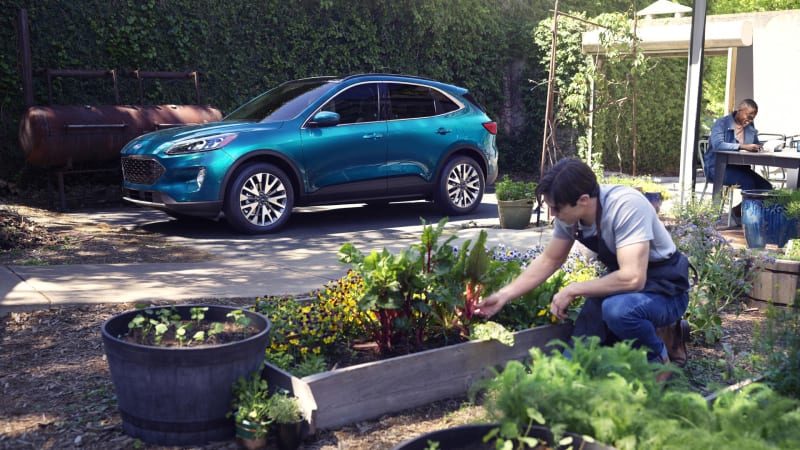
Now, there's another reason for this extra car-like direction and the lack of an off-road-oriented trim level. Rather than offering something similar to the Toyota RAV4 Adventure, Ford will soon offer a separate, more rugged compact crossover to fill that niche, something weíve been calling the ďBaby Bronco.Ē We expect that itíll wear boxy sheetmetal and offer some light-duty off-road capabilities, in the vein of the Jeep Compass Trailhawk. That strategy lets the Escape specialize as a car-like vehicle with swoopy styling and kinda-sorta sporty driving dynamics, while the Baby Bronco will be more rugged and truck-like. What neither of them seems likely to do, however, is fill the void in price point left by the loss of the significantly less expensive Focus.
Americans have shown that they love crossovers, but they also love a bargain. And while the 2020 Escape is a good product that will likely win over plenty of customers and dovetail nicely with the upcoming Baby Bronco, thereís an awfully big gap between the $21,090 EcoSport and a $26,080 Escape. And really, the EcoSport isnít a particularly desirable product, regardless of price.
But standing on its own, the 2020 Escape is a crossover that owners are going to like. Itís a much better vehicle than the Escape it replaces, benefiting greatly from its next-generation Euro-Focus chassis and more fuel-efficient engine options. And, with the caveat that we donít yet know if the Escapeís more adventurous Bronco-inspired sibling will be similarly successful in its mission and execution, it seems that Fordís two-pronged compact crossover strategy is off to a good start.
Americans have shown that they love crossovers, but they also love a bargain. And while the 2020 Escape is a good product that will likely win over plenty of customers and dovetail nicely with the upcoming Baby Bronco, thereís an awfully big gap between the $21,090 EcoSport and a $26,080 Escape. And really, the EcoSport isnít a particularly desirable product, regardless of price.
But standing on its own, the 2020 Escape is a crossover that owners are going to like. Itís a much better vehicle than the Escape it replaces, benefiting greatly from its next-generation Euro-Focus chassis and more fuel-efficient engine options. And, with the caveat that we donít yet know if the Escapeís more adventurous Bronco-inspired sibling will be similarly successful in its mission and execution, it seems that Fordís two-pronged compact crossover strategy is off to a good start.
Source
#48
Lexus Fanatic
I really dont care for the looks of it from the front...
#49
Lexus Fanatic
iTrader: (20)
a much better offering from ford, but i still think the interior isn't very special.
#50
The 2020 Ford Escape hybrid drives a lot like its traditionally gas-powered siblings, and thatís a good thing. We've already told you about how the latest Escape is very car-like, with a playful chassis and a mildly sporty demeanor. The hybrid doesnít change that character in any significant way Ė itís no fun-sapping miserly version aimed solely at those trying to save a buck at the pump Ė and in fact itís not even separated into its own model. The electrified powertrain first shows up in the lineup as part of the SE Sport package, which sits above the base S and SE trim levels. The hybrid powertrain is also available on the range-topping Titanium trim.
It seems a little strange to use the Sport designation, since the hybrid Escape isnít sportier than any other 2020 Escape, not least of which being those powered by the 250-horsepower 2.0-liter EcoBoost. On the other hand, there isnít any performance drawback, either.
So letís focus on whatís different and interesting about the hybrid. Underhood is a 2.5-liter naturally aspirated four-cylinder engine running on the efficient Atkinson combustion cycle paired up with an 88-kilowatt electric motor. Combined, the hybridized powertrain sends 200 horsepower and 152 pound-feet of torque to either the front wheels, or optionally through the same all-wheel-drive system found in the regular Escape.
It seems a little strange to use the Sport designation, since the hybrid Escape isnít sportier than any other 2020 Escape, not least of which being those powered by the 250-horsepower 2.0-liter EcoBoost. On the other hand, there isnít any performance drawback, either.
So letís focus on whatís different and interesting about the hybrid. Underhood is a 2.5-liter naturally aspirated four-cylinder engine running on the efficient Atkinson combustion cycle paired up with an 88-kilowatt electric motor. Combined, the hybridized powertrain sends 200 horsepower and 152 pound-feet of torque to either the front wheels, or optionally through the same all-wheel-drive system found in the regular Escape.
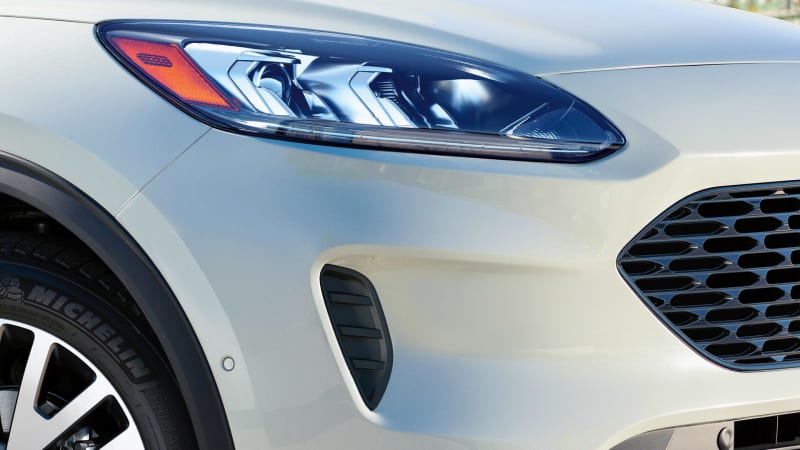
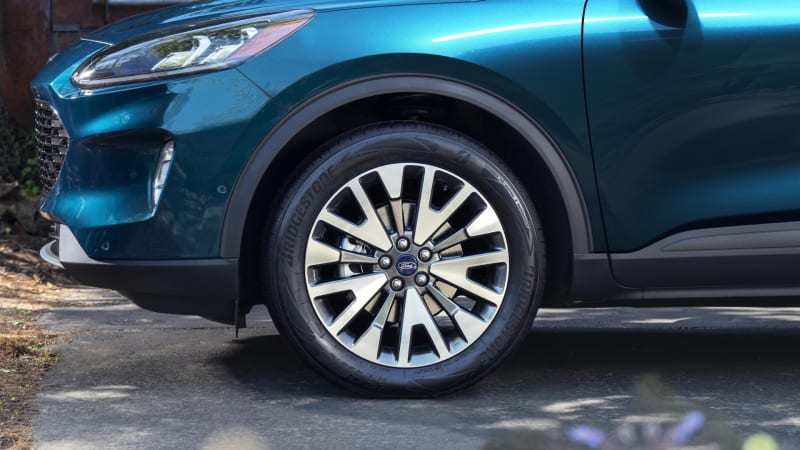
While the hybrid offers the lowest peak torque of the 2020 Escapeís three powertrain options, it doesnít really feel that way from behind the wheel. The electric motorís ample torque off idle helps the Escape SE Sport hybrid scoot off the line with reasonable oomph. Unlike EcoBoosted Escapes that use a conventional eight-speed automatic, the hybrid drivetrain features an electronically controlled continuously variable transmission that can drone at times, particularly during steady-state acceleration, as is the case with Toyota's hybrids.
Speak of the devil, the 2020 Escape hybrid's natural competitor is the 2019 Toyota RAV4 Hybrid, which produces 219 horsepower and 163 lb-ft while returning 41 mpg city and 38 highway. Normally, weíd compare that directly with the 2020 Escape hybridís economy numbers, but Ford hasnít released their EPA estimates yet. We can glean some hints from other specs: Ford expects the Escape SE Sport to have a range of more than 550 miles from its 14.2-gallon gas tank. Some back-of-the-napkin math indicates the hybrid Escape should get something near 39 mpg on the highway, though that estimate probably applies specifically to the front-wheel-drive version.
If thereís an efficiency discrepancy between the hybrid drivetrains of the RAV4 and Escape ó and again, we wonít know for sure until there are official EPA estimates ó it may be due to the Fordís smaller liquid-cooled lithium-ion battery pack, which at 1.1 kWh, is down half a kilowatt hour from the nickel-metal hydride Toyota.
The location of Fordís battery pack under the car (as opposed to under the back seat as in the hybrid RAV4) means the floor under the rear seats is raised by about 1.6 inches, which reduces rear seat legroom from a maximum of 40.7 in the non-hybrid Escape to 38.9 in the hybrid. The cargo area is similarly reduced from 65.4 cubic feet to 60.8, well below the 69.8 offered by the RAV4 Hybrid. Ford says the Escapeís hybrid powertrain is rated to tow up to 1,500 pounds, which is less than the RAV4ís 1,750-pound rating and a lot less than the 3,500-pound max rating of an Escape with the 2.0-liter EcoBoost.
The Escape SE Sport hybrid starts at $29,450 (including a $1,195 destination charge). Thatís $1,160 more than the SE with its standard 1.5-liter three-cylinder, but it also includes a 12.3-inch digital instrument cluster that adds a premium, techy feel to the cabin. That strikes us as a reasonable price increase for what we expect will be significantly improved fuel efficiencyand mildly improved performance over the base 1.5-liter engine. The Hybrid Titanium costs $34,595 and includes a leather interior with heated and powered front seats, a 10-speaker Bang & Olufsen sound system, and Fordís Co-Pilot360 Assist+ system.
Like other 2020 Escapes, the hybridís chassis feels stiff, which helps contribute to a comfortably firm ride and playful handling characteristics. The steering is reasonably quick though devoid of much feedback, which is pretty much par for the compact crossover course. We spent most of our time in the default Normal drive mode, figuring thatís where the majority of owners will keep their Escapes, and found that it offers good response and generally refined manners from the engine and transmission. Thereís an Eco mode that makes the Escape feel a bit sluggish, but it ought to prove handy for owners who want to eke out max mileage from a tank of gas.
The hybrid is palpably slower than the optional 2.0-liter EcoBoost, but while we didnít do any instrumented testing, it feels like it will dispatch the run to 60 with greater pace than the base three-cylinder. Ford targeted a 15% quicker 0-60 time for its new hybrid Escape compared to the previous generationís base 1.5-liter turbocharged four-cylinder, and weíd wager they hit the mark. As youíd expect, the gas engine fires at anything more than gentle acceleration at low speed, and while the driver may sense a change in vibration, the transition from pure electric to internal combustion isnít bothersome.
Speak of the devil, the 2020 Escape hybrid's natural competitor is the 2019 Toyota RAV4 Hybrid, which produces 219 horsepower and 163 lb-ft while returning 41 mpg city and 38 highway. Normally, weíd compare that directly with the 2020 Escape hybridís economy numbers, but Ford hasnít released their EPA estimates yet. We can glean some hints from other specs: Ford expects the Escape SE Sport to have a range of more than 550 miles from its 14.2-gallon gas tank. Some back-of-the-napkin math indicates the hybrid Escape should get something near 39 mpg on the highway, though that estimate probably applies specifically to the front-wheel-drive version.
If thereís an efficiency discrepancy between the hybrid drivetrains of the RAV4 and Escape ó and again, we wonít know for sure until there are official EPA estimates ó it may be due to the Fordís smaller liquid-cooled lithium-ion battery pack, which at 1.1 kWh, is down half a kilowatt hour from the nickel-metal hydride Toyota.
The location of Fordís battery pack under the car (as opposed to under the back seat as in the hybrid RAV4) means the floor under the rear seats is raised by about 1.6 inches, which reduces rear seat legroom from a maximum of 40.7 in the non-hybrid Escape to 38.9 in the hybrid. The cargo area is similarly reduced from 65.4 cubic feet to 60.8, well below the 69.8 offered by the RAV4 Hybrid. Ford says the Escapeís hybrid powertrain is rated to tow up to 1,500 pounds, which is less than the RAV4ís 1,750-pound rating and a lot less than the 3,500-pound max rating of an Escape with the 2.0-liter EcoBoost.
The Escape SE Sport hybrid starts at $29,450 (including a $1,195 destination charge). Thatís $1,160 more than the SE with its standard 1.5-liter three-cylinder, but it also includes a 12.3-inch digital instrument cluster that adds a premium, techy feel to the cabin. That strikes us as a reasonable price increase for what we expect will be significantly improved fuel efficiencyand mildly improved performance over the base 1.5-liter engine. The Hybrid Titanium costs $34,595 and includes a leather interior with heated and powered front seats, a 10-speaker Bang & Olufsen sound system, and Fordís Co-Pilot360 Assist+ system.
Like other 2020 Escapes, the hybridís chassis feels stiff, which helps contribute to a comfortably firm ride and playful handling characteristics. The steering is reasonably quick though devoid of much feedback, which is pretty much par for the compact crossover course. We spent most of our time in the default Normal drive mode, figuring thatís where the majority of owners will keep their Escapes, and found that it offers good response and generally refined manners from the engine and transmission. Thereís an Eco mode that makes the Escape feel a bit sluggish, but it ought to prove handy for owners who want to eke out max mileage from a tank of gas.
The hybrid is palpably slower than the optional 2.0-liter EcoBoost, but while we didnít do any instrumented testing, it feels like it will dispatch the run to 60 with greater pace than the base three-cylinder. Ford targeted a 15% quicker 0-60 time for its new hybrid Escape compared to the previous generationís base 1.5-liter turbocharged four-cylinder, and weíd wager they hit the mark. As youíd expect, the gas engine fires at anything more than gentle acceleration at low speed, and while the driver may sense a change in vibration, the transition from pure electric to internal combustion isnít bothersome.
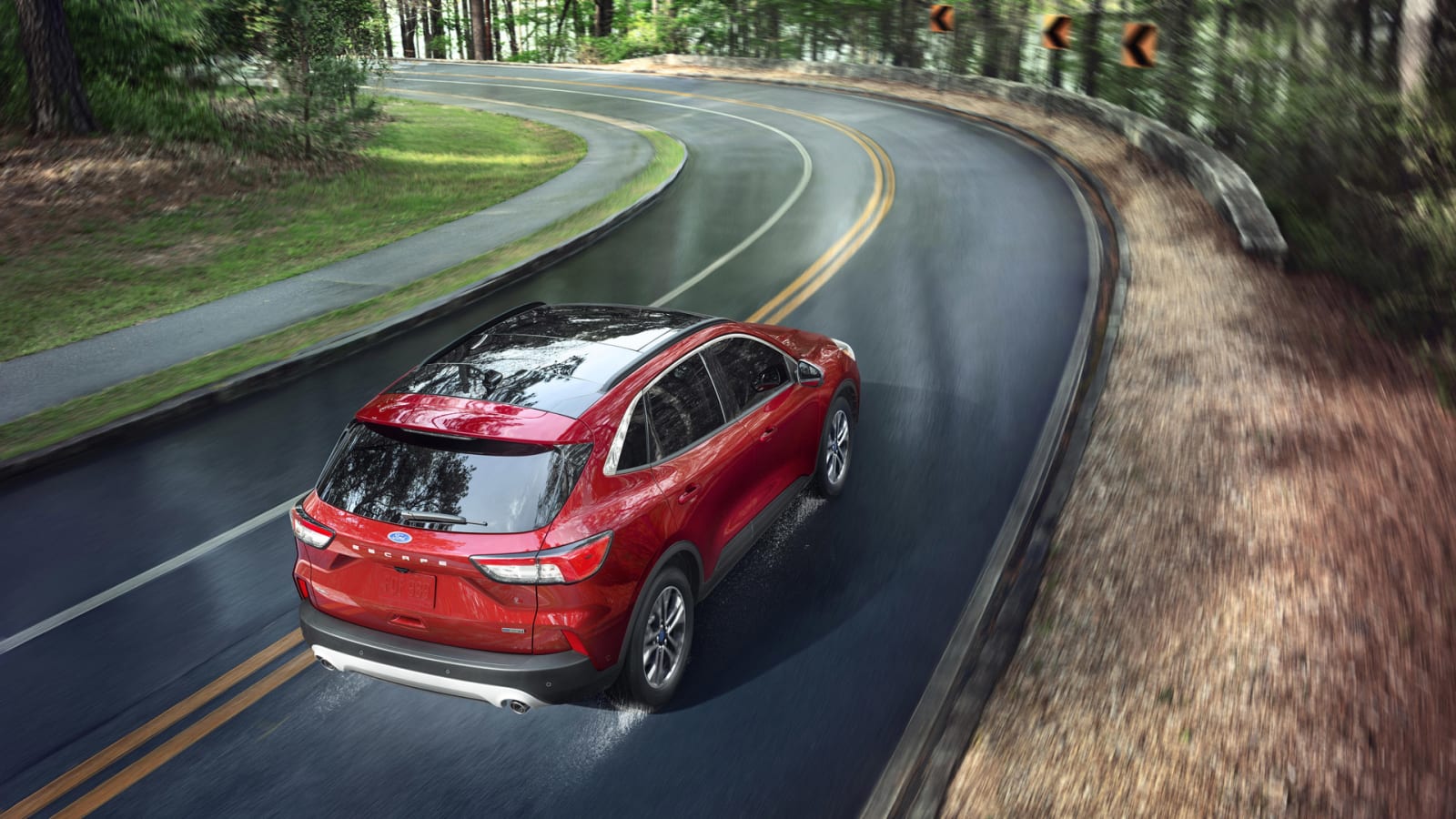
Ford says it can run solely on electricity up to 85 mph, and we found that speed to be sufficiently high that the hybrid Escape shuts off its gas-powered engine often and Ė as long as we were very easy on the throttle Ė for extended periods of time. The digital display shows how much of the current drive has been accomplished under electric power, and we were surprised to see that nearly half of the 100 or so miles we spent behind the wheel used no gasoline at all. When it comes time to stop, we didnít notice any glaring issues with the transition from regenerative to friction braking, either.
Buyers looking for maximum fuel savings will be more interested in the upcoming Escape plug-in hybrid thatís projected to offer at least 30 miles of electric propulsion. Until that model comes sometime next year, we think most owners will happily drive the hybrid Escape without ever concerning themselves with the different powertrain. And thatís the point of this particular hybrid option. If you can live with the reduction in rear seat and cargo space, the regular non-plug hybrid-powered model offers the same car-like package, semi-sporty ride and handling, and attractive looks as any other 2020 Escape. What weíre not sure about, and wonít really know until official efficiency figures show up, is if itís a better option than Toyotaís latest RAV4 Hybrid or the recently announced 2020 Honda CR-V Hybrid.
Buyers looking for maximum fuel savings will be more interested in the upcoming Escape plug-in hybrid thatís projected to offer at least 30 miles of electric propulsion. Until that model comes sometime next year, we think most owners will happily drive the hybrid Escape without ever concerning themselves with the different powertrain. And thatís the point of this particular hybrid option. If you can live with the reduction in rear seat and cargo space, the regular non-plug hybrid-powered model offers the same car-like package, semi-sporty ride and handling, and attractive looks as any other 2020 Escape. What weíre not sure about, and wonít really know until official efficiency figures show up, is if itís a better option than Toyotaís latest RAV4 Hybrid or the recently announced 2020 Honda CR-V Hybrid.
#51
The front-drive model just edges out the RAV4 Hybrid in combined fuel economy
Fuel economy for the 2020 Ford Escape hybrid has been revealed, and it's impressive. The most frugal variant is the front-drive model, which delivers a whopping 44 mpg in the city, 37 on the highway and 41 in combined driving. The all-wheel-drive version's city fuel economy dips to 43, highway economy stays the same, and combined is 40.
These numbers put the Escape hybrid right inline with current and upcoming non-plug-in hybrid competition. The Toyota RAV4 Hybrid, which is only available with all-wheel drive, ties the all-wheel-drive Escape's 40 mpg combined rating. Highway economy is slightly worse at 41 mpg, and city fuel economy is slightly better at 38 mpg. The upcoming Honda CR-V Hybrid doesn't have official numbers yet, but estimates put it at potentially 42 mpg combined on the highway with all-wheel drive and 40 combined with front-wheel drive. The Kia Niro is the king of the segment for fuel economy, with its least-efficient Touring model getting 43 mpg combined, and its most efficient FE getting 50. However, it doesn't offer all-wheel drive at all, and it's a bit smaller than the other competitors listed here. The Nissan Rogue hybrid was discontinued for the 2020 model year, but 2019 models are likely still lurking, and they sit well behind the Ford, Toyota and Honda with a combined fuel economy of 34 mpg with front-wheel drive, and 33 with all-wheel drive.
When it comes to pricing, the Toyota has a lower base price at $29,220, which includes all-wheel drive. The Ford Escapestarts at $29,450 for the front-wheel-drive version, and the all-wheel-drive model starts at $30,950.
These numbers put the Escape hybrid right inline with current and upcoming non-plug-in hybrid competition. The Toyota RAV4 Hybrid, which is only available with all-wheel drive, ties the all-wheel-drive Escape's 40 mpg combined rating. Highway economy is slightly worse at 41 mpg, and city fuel economy is slightly better at 38 mpg. The upcoming Honda CR-V Hybrid doesn't have official numbers yet, but estimates put it at potentially 42 mpg combined on the highway with all-wheel drive and 40 combined with front-wheel drive. The Kia Niro is the king of the segment for fuel economy, with its least-efficient Touring model getting 43 mpg combined, and its most efficient FE getting 50. However, it doesn't offer all-wheel drive at all, and it's a bit smaller than the other competitors listed here. The Nissan Rogue hybrid was discontinued for the 2020 model year, but 2019 models are likely still lurking, and they sit well behind the Ford, Toyota and Honda with a combined fuel economy of 34 mpg with front-wheel drive, and 33 with all-wheel drive.
When it comes to pricing, the Toyota has a lower base price at $29,220, which includes all-wheel drive. The Ford Escapestarts at $29,450 for the front-wheel-drive version, and the all-wheel-drive model starts at $30,950.
#52
Lexus Fanatic
Did you look at the Titanium version?
 I agree that the base interior (like with the RAV-4) is not very impressive at all, but there is a big difference between the base and Titanium-level trim. Ford charges the extra money on the Titanium for a good reason.
I agree that the base interior (like with the RAV-4) is not very impressive at all, but there is a big difference between the base and Titanium-level trim. Ford charges the extra money on the Titanium for a good reason.
Thread
Thread Starter
Forum
Replies
Last Post



 The last version, derived from the European Ford Kuga, looked awkward.
The last version, derived from the European Ford Kuga, looked awkward.
